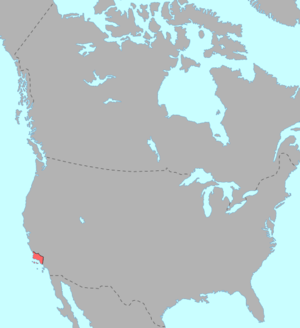Chumashan languages
| Chumash | |
|---|---|
| S.hamala | |
| Geographic distribution: | southern coastal California |
| Extinct | since the 1960s |
| Linguistic classification: | One of the world's primary language families |
| Subdivisions: |
|
| Glottolog: | chum1262[1] |
|
Pre-contact distribution of Chumashan languages | |
Chumashan (native name S.hamala /sʰamala/; English name from čʰumaš /t͡ʃʰumaʃ/, meaning "Santa Cruz Islander") is a family of languages that were spoken on the southern California coast by Native American Chumash people, from the Coastal plains and valleys of San Luis Obispo to Malibu, neighboring inland and Transverse Ranges valleys and canyons east to bordering the San Joaquin Valley, to three adjacent Channel Islands: San Miguel, Santa Rosa, and Santa Cruz.[2]
The Chumashan languages may be, along with Yukian and perhaps languages of southern Baja such as Waikuri, one of the oldest language families established in California, before the arrival of speakers of Penutian, Uto-Aztecan, and perhaps even Hokan languages. Chumashan, Yukian, and southern Baja languages are spoken in areas with long-established populations of a distinct physical type. The population in the core Chumashan area has been stable for the past 10,000 years. However, the attested range of Chumashan is recent (within a couple thousand years). There is internal evidence that Obispeño replaced a Hokan language and that Island Chumash mixed with a language very different from Chumashan; the islands were not in contact with the mainland until the introduction of plank canoes in the first millennium AD.[3]
All of the Chumashan languages are now extinct, although they are well documented in the unpublished fieldnotes of linguist John Peabody Harrington. Especially well documented are Barbareño, Ineseño, and Ventureño. The last native speaker of a Chumashan language was Barbareño speaker Mary Yee, who died in 1965.
Family division
Languages
Six Chumashan languages are attested, all now extinct.
I. Northern Chumash
- 1. Obispeño (also known as Northern Chumash) (†)
II. Southern Chumash
- a. Island Chumash (mixed with non-Chumash)
- 2. Island Chumash (also known as Ysleño, Isleño, Cruzeño) (†)
- b. Central Chumash
- 3. Purisimeño (†)
- 4. Ineseño (also spelled Inezeño) (†)
- 5. Barbareño (†)
- 6. Ventureño (†)
Obispeño was the most divergent Chumashan language. Ineseño and Barbareño may have been dialects of the same language. There is very little documentation of Purisimeño. Ventureño had several dialects. Island Chumash had different dialects on Santa Cruz Island and Santa Rosa Island, but all speakers were relocated to the mainland in the early 19th century. John Peabody Harrington conducted fieldwork on all the above Chumashan languages, but obtained the least data on Island Chumash, Purisimeño, and Obispeño. There is no linguistic data on Cuyama, though ethnographic data suggests that it was likely Chumash (Interior Chumash).
Post-contact
The languages are named after the local Franciscan Spanish missions in California where Chumashan speakers were relocated and aggregated between the 1770s and 1830s:
- Obispeño—Mission San Luis Obispo de Tolosa
- Purisimeño—Mission La Purísima Concepción
- Ineseño—Mission Santa Inés
- Barbareño—Mission Santa Barbara
- Ventureño—Mission San Buenaventura
Genetic relations
Roland Dixon and Alfred L. Kroeber suggested that the Chumashan languages might be related to the neighboring Salinan in a Iskoman grouping.[4] Edward Sapir accepted this speculation and included Iskoman in his classification of Hokan.[5] More recently it has been noted that Salinan and Chumashan shared only one word, which the Chumashan languages probably borrowed from Salinan (the word meant 'white clam shell' and was used as currency).[6] As a result, the inclusion of Chumashan into Hokan is now disfavored by most specialists, and the consensus is that Chumashan has no identified linguistic relatives.[7]
Characteristics
The Chumashan languages are well known for their consonant harmony (regressive sibilant harmony). Mithun presents a scholarly synopsis of Chumashan linguistic structures.[8]
See also
- Chumash people
- Rock art of the Chumash people
- Burro Flats Painted Cave
- Population of Native California
- Native Americans in the United States
Notes
- ↑ Nordhoff, Sebastian; Hammarström, Harald; Forkel, Robert; Haspelmath, Martin, eds. (2013). "Chumashan". Glottolog. Leipzig: Max Planck Institute for Evolutionary Anthropology.
- ↑ Grant 1978
- ↑ Golla, Victor. (2011). California Indian Languages. Berkeley: University of California Press. ISBN 978-0-5202-6667-4
- ↑ Dixon and Kroeber 1913
- ↑ Sapir 1917
- ↑ Klar 1977
- ↑ Mithun 1999:390
- ↑ Mithun 1999:390-392
Bibliography
- Campbell, Lyle. (1997). American Indian languages: The historical linguistics of Native America. New York: Oxford University Press. ISBN 0-19-509427-1.
- Dixon, Roland R.; & Kroeber, Alfred L. (1913). New Linguistic Families in California. American Anthropologist 15:647-655.
- Goddard, Ives (Ed.). (1996). Languages. Handbook of North American Indians (W. C. Sturtevant, General Ed.) (Vol. 17). Washington, D. C.: Smithsonian Institution. ISBN 0-16-048774-9.
- Klar, Kathryn. (1977). Topics in historical Chumash grammar. (Doctoral dissertation, University of California, Berkeley).
- Kroeber, Alfred Louis (1910). The Chumash and Costanoan languages. Berkeley, The University Press. Retrieved 2012-08-26.
- Mithun, Marianne. (1999). The languages of Native North America. Cambridge: Cambridge University Press. ISBN 0-521-23228-7 (hbk); ISBN 0-521-29875-X.
- Grant, Campbell. (1978). Chumash:Introduction. In California Handbook of North American Indians (William C. Sturtevant, General Ed.) Vol. 8 (Robert F. Heizer, Volume Ed.). Washington, D. C.: Smithsonian Institution.
- Sapir, Edward. (1917). The Position of Yana in the Hokan Stock. University of California Publications in American Archaeology and ethnology 13:1–34. Berkeley: University of California.
| ||||||||||||||||||||||||||||||||||||||||||||||||||||||||||||||
| ||||||
